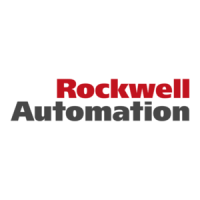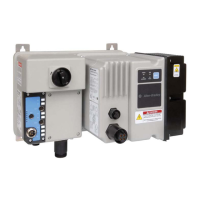Do you have a question about the Rockwell Automation 2080-L70E-24QBB and is the answer not in the manual?
| Model | 2080-L70E-24QBB |
|---|---|
| Category | Controller |
| Number of I/O Points | 24 |
| Power Supply | 24V DC |
| Digital Inputs | 16 |
| Digital Outputs | 8 |
| Ethernet Ports | 1 |
| Communication Ports | Ethernet, Serial |
Defines WARNING notices for hazardous environments, potential injury, death, property damage, or economic loss.
Defines ATTENTION notices for personal injury, death, property damage, or economic loss, focusing on hazard identification and consequence.
Defines SHOCK HAZARD labels on equipment warning about dangerous voltage presence.
Defines BURN HAZARD labels on equipment warning about dangerous surface temperatures.
Defines ARC FLASH HAZARD labels warning of severe injury or death from Arc Flash, recommending PPE and regulatory compliance.
Describes the economical brick style controllers with embedded inputs/outputs, plug-in module capacity, and expansion I/O support for Micro850/870.
Details the Micro830 10/16-point and 24-point controllers, including status indicators and terminal block descriptions.
Details the Micro850 24-point and 48-point controllers, including controller description, status indicators, and terminal blocks.
Details the Micro870 24-point controllers, including controller description, status indicators, and terminal blocks.
Introduces Connected Components Workbench software for controller programming, device configuration, and HMI design.
Explains features allowing changes in run mode like Run Mode Change (RMC) and RMCC.
Details RMC as a productivity feature for logic modifications in a running project without disconnecting.
Describes RMCC for reusing programs across controllers by changing address configuration in run mode.
Emphasizes the importance of safety in system installation and recommends reviewing specific considerations.
Advises locating main power disconnect for easy access and de-energizing all power sources before working.
Provides mounting dimensions for Micro830 10/16-point and 24-point controllers, excluding feet or DIN rail latches.
Details mounting dimensions for Micro830 10/16-point and 24-point controllers, excluding feet or DIN rail latches.
Provides recommendations for wiring, including spacing, routing paths, signal separation, and labeling.
Explains the requirement for surge suppression to protect controller output contacts and extend operating life.
Lists Allen-Bradley surge suppressors suitable for relays, contactors, and starters, categorized by device and coil voltage.
States the product is intended for mounting on a well-grounded surface and refers to industrial automation wiring guidelines.
Illustrates wiring diagrams for Micro800 controllers, showing sinking/sourcing inputs and indicating high-speed inputs/outputs.
Provides relevant information on minimizing electrical noise and includes wiring examples for I/O.
Lists protocols supported by Micro830/850/870 controllers, including Modbus RTU, CIP Serial, ASCII, DNP3, EtherNet/IP, Modbus TCP, DHCP, and Sockets.
Guides on configuring the serial port driver as CIP Serial, Modbus RTU, ASCII, or Shutdown.
Provides step-by-step instructions for configuring the CIP Serial driver in Connected Components Workbench.
Guides on configuring the serial port driver for Modbus RTU, including parameters like Baud Rate, Parity, and Modbus Role.
Explains configuring Internet Protocol (IP) settings for EtherNet/IP communication.
Explains configuring serial ports for DF1 Full-Duplex and Ethernet for DNP3 over IP.
Details application layer configuration for DNP3 slave, including driver, node address, baud rate, parity, and stop bits.
Details parameters for DNP3 slave application layer, including unsolicited response settings and event management.
Summarizes supported DNP3 objects and the mapping required between them and controller variables.
Covers generating DNP3 events and reporting them via polled or unsolicited responses.
Explains how errors in DNP3 subsystems are logged in Communication Diagnostics.
Details diagnostic counters and errors for the Ethernet channel in DNP3 Slave subsystem.
Explains where to find diagnostic information for Secure Authentication in Connected Components Workbench.
Provides an overview of running/executing programs with a Micro800 controller, including scan cycles and POU execution.
Explains how controller activities like interrupts and communication can affect program scan cycle time.
Details memory allocation for Micro800 controllers based on controller type and typical project specifications.
Outlines Micro850/870 EtherNet/IP functionality including topologies, communication rates, and duplicate IP address detection.
Guides on adding PowerFlex 520-series and Kinetix 5100 drives using predefined tags or generic profiles.
Details module properties parameters including Name, Type, IP Address, Mode, Catalog, Revision, and Connection settings.
Explains the use of predefined UDFBs for programming PowerFlex 520-series and Kinetix 5100 drives.
Lists possible connection faults and their corrective actions for EtherNet/IP devices.
Explains PTO Motion control using pulse and direction outputs for precise position/velocity control.
Outlines the elements of Micro800 motion control: Pulse Train Outputs, Axis, Motion Function Blocks, and Jerk.
Describes Motion Control components: Pulse Train Outputs, Axis, Motion Function Blocks, and Jerk.
Details required input/output signals for motion axes, including fixed PTO and configurable I/O.
Introduces function blocks that instruct an axis for position, distance, velocity, and state.
Lists movement function blocks for commanding axis motion: MC_MoveAbsolute, MC_MoveRelative, MC_MoveVelocity, MC_Home, MC_Stop, MC_Halt.
Provides general rules for using motion control function blocks, including input parameters, limits, and error codes.
Details Error and ErrorID outputs for function blocks and describes types of errors.
Illustrates axis behavior states and how motion commands transition states.
Lists predefined axis states like Disabled, Standstill, Discrete Motion, Continuous Motion, Homing, Stopping, and Stop Error.
Defines types of motion position limits: Hard Limits, Soft Limits, and PTO Pulse Limits.
Describes hard limits referring to physical hardware inputs like limit switches and proximity sensors.
Explains soft limits as data values managed by the motion controller, activated after homing.
Covers three types of stops: Immediate Hardware Stop, Immediate Soft Stop, and Decelerating Soft Stop.
Describes Immediate Stop controlled by hardware, cutting off PTO pulse immediately if Hard Stop is enabled.
Details scenarios for Immediate Soft Stop, including PTO Pulse Limit reached or emergency stop configuration.
Explains Decelerating Soft Stop, which can be delayed and applies to scenarios like hard limit detection or soft limit reach.
Introduces Axis_Ref data structure containing motion axis information and its use in function blocks.
Describes the Axis_Ref data structure as input/output for motion function blocks, containing axis state and diagnostics.
Explains that all motion control function blocks share the same ErrorID definition.
Discusses controller issues where recovery is impossible, leading to stopped operation and major fault reporting.
Introduces HSC feature, its components (hardware and instructions), and configuration.
Defines HSC for detecting fast pulses and initiating control operations based on preset values.
Lists HSC capabilities like 100 kHz operation, direct output control, 32-bit data, programmable presets, and on-the-fly parameter changes.
Details HSC input mapping for Micro830/850/870 controllers across different modes and controller sizes.
Describes HSC data structures: HSC APP Data Structure and HSC STS Data Structure.
Explains defining HSC APP Data (configuration) when programming an HSC, noting data should not be changed during counting.
Explains the HSC function block for starting/stopping counting, refreshing status, reloading settings, and resetting the accumulator.
Details HscCmd as an input parameter for controlling HSC operations like start, stop, reload, and reset.
Explains the HSC Set Status function block for changing HSC counting status when not counting.
Describes configuring HSC as PLS or rotary cam switch using PLS data for limit/cam positions.
Details the PLS data structure as a flexible array for setting limit/cam positions and output data.
Explains PLS operation where HSC counts pulses, and output data is written via HSC mask when presets are reached.
Explains HSC interrupts as events that suspend program execution to perform selected user logic.
Guides on configuring HSC interrupts by selecting HSC and HSC ID in the User Interrupt configuration window.
Describes HSC interrupt status bits like Enabled, Executing (EX), Pending (PE), and Lost (LS) for monitoring and control program logic.
Explains how operations disrupting controller operation are restricted based on the controller operating mode.
Enforces exclusive access for only one software session to the controller application, regardless of password protection.
Restricts access to programming software connections, preventing upload/download without the correct password.
Details compatibility of Controller Password feature with software versions and hardware revisions.












